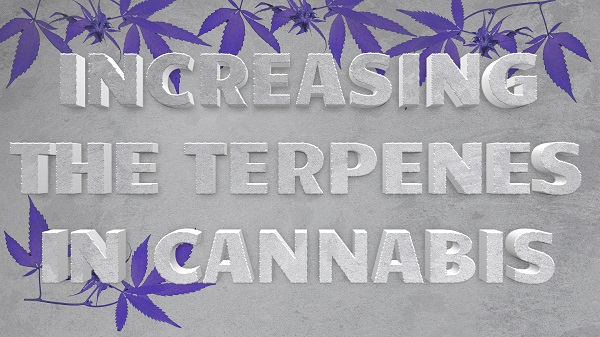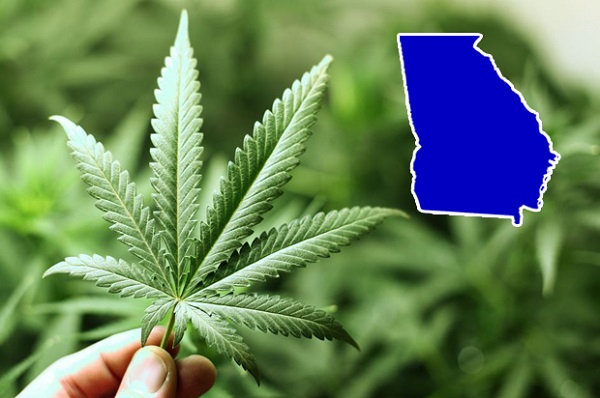Terpenes are the most common compounds found in cannabis after cannabinoids. In the human body, terpenes can have medicinal effects as well as being responsible for the characteristic taste and flavor of cannabis. There are several ways growers can increase the terpenes in cannabis at various stages of production, from sprouting to drying to curing.
If you’re just starting out in cannabis growing, it’s important to understand that terpenes are a combination of carbon and hydrogen, built on a certain amount of isoprene links. They can affect the quality of the high that users experience, and together with cannabinoids and flavonoids form what is known as an entourage effect.
Approximately 10-30% of the content of cannabis resin is made up of various terpenes, with some being common and others rare. The percentage of certain terpenes and their ratios can vary depending on the plant variety and environmental conditions.
Plants produce terpenes to attract pollinators, beneficial insects and to deter animals or pests from the plant. Because cannabis plants are pollinated by the wind, they produce terpenes mainly to ward off herbivores and pests.
In cannabis plants, terpenes are produced in resin glands called trichomes. So in order to produce more terpenes, cannabis plants need to produce more trichomes. There are many ways to help your cannabis plants produce more terpenes, and here are the most useful and common ones.
Genetic modification
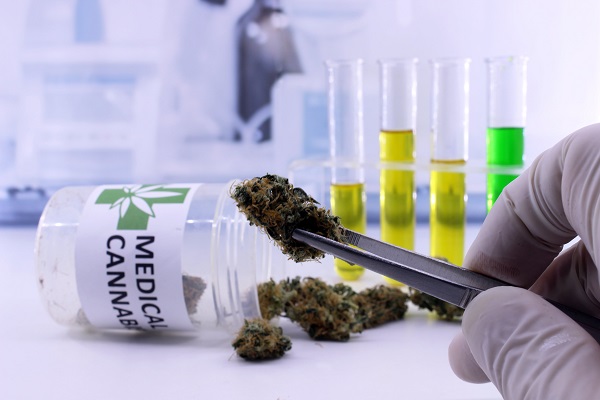
Good genetics is the basis of everything. Even with the best conditions and the use of all the methods mentioned in this article, it is impossible to turn a weed into a first-class cannabis strain. Because of cannabis prohibition, breeders primarily focused on maximizing THC levels.
At the time it made perfect sense, because cannabis research was very limited and we knew very little about the other compounds found in the plant. The aroma of cannabis wasn’t really what the producers wanted. It attracted unwanted attention and increased the risk of arrest.
With the legalization of cannabis, times are changing. Consumers no longer just want the plant material to make them feel euphoric, but they also want cannabis to smell and taste good. After studying the plant in more detail, we discovered that terpenes also have medicinal properties and effects.
To meet the needs of the market, growers began breeding strains with higher terpene content. If you’re using cannabis for treatment, you need to choose strains with specific terpenes that are best suited for your condition. And if you’re smoking for pleasure, you’re likely to choose what tastes and flavors you prefer. Cannabis dispensaries usually offer analysis of terpenes as well as cannabinoids, listing the dominant terpenes in their strains.
There are many seed banks on the European market, which give cannabis enthusiasts the opportunity to select different strains and grow them, creating their own breeding genes with impressive terpene profiles. In this article, we offer five of our favorite strains with exquisite flavor.
Soil
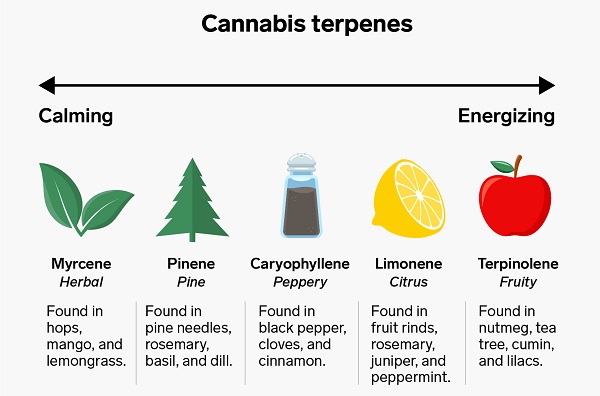
While it is possible to maximize terpene yields in any growing system, the best and most consistent medium for them is soil. Quality soil ensures optimal pH and alkalinity levels, maximizes nutrient uptake and supports photosynthesis. Growing cannabis on native soils reveals the region’s terroir.
Terroir is determined by the environment in which the plants grew and affects their flavor and aroma. Just as wines produced in certain regions differ in flavor, even when made from the same specific grape variety. It’s the same story with cannabis plants.
Creating quality soil is a science. If your goal is to increase the terpenes, you should increase the amount of sugar in the plants. Since plants cannot absorb the added sugar, you should make sure that the nutrient regimen is conducive to natural sugar production in the plants. In the next article we will look at how this can be done.
Nutrients, additives and enhancers
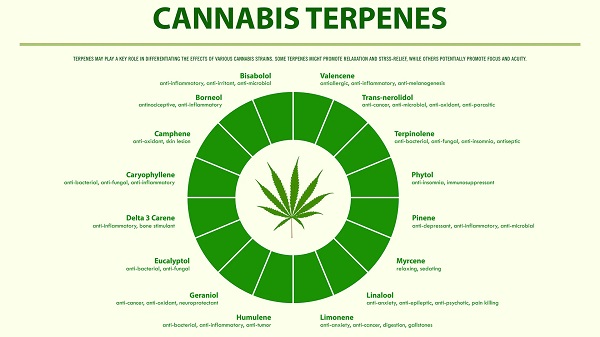
During cannabis flowering, it is important that the plants get enough sugar or carbohydrates. This will help to produce large, dense buds with a high resin and terpene content. The amount of carbohydrates the plant requires can vary throughout its life cycle and have a significant effect on bud maturation.
Valuable nutrients and flavor supplements are carbohydrate-based. The addition of sugar to the root zone stimulates microbial populations, giving the plants access to additional nutrients and sugars.
There are also special additives that promote terpene production. These are based on plant compounds known as bioosmotic enhancers. These additives stimulate plants to increase the production of terpenes and essential oils, which ultimately affects the quality and taste of the crop.
Activation of stress
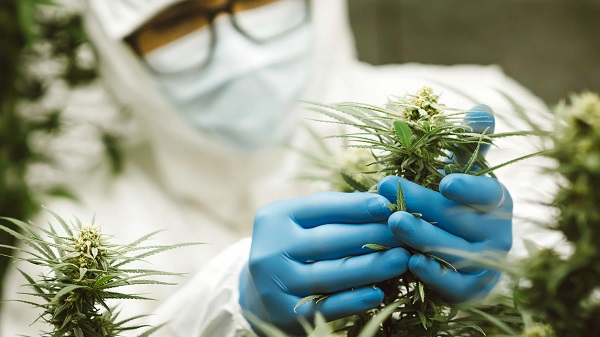
Trichomes are a defense mechanism produced by cannabis plants in response to stresses and various types of attacks. The natural function of this mechanism is to protect the plant and seeds from extreme conditions: cold weather, ultraviolet rays, pests and diseases.
Gardeners can use this mechanism for their own needs. Shallow stress caused during flowering can promote the production of more trichomes and, as a result, cannabinoids and terpenes. However, too much stress can stop photosynthesis and harm the plants. Therefore, these methods do not work on autoflowering species, which complete their growing cycle in 12 to 13 weeks. Any additional stress can lead to poor yields.
Low temperatures
Cold weather is one of the most significant stresses on cannabis plants. It can cause changes in plant metabolism. If it occurs during the final stage of flowering, resin production will increase and it will have little effect on the crop.
Lowering the temperature can help speed up and improve yields. This is done by gradually lowering the temperature by 5 °C during the last two weeks of flowering. This method mimics fall conditions, and the plant responds by directing the remaining energy to produce more resin to protect its seeds. By this point, the buds are fully mature and only need to mature, which will result in much higher quality resin coverage and terpene content.
Humidity reduction
The optimal humidity for cannabis flowering is 50-60%. Decreasing the humidity to 30% will cause a little stress to the plants, and the production of terpenes will increase. This can be achieved by adding more fans or a dehumidifier in the room. Lower humidity will also help reduce the risk of mold and mildew.
Reduced irrigation
When you water less and less frequently, you are simulating a drought. As with any stress, a plant’s natural reaction is to protect itself and its seeds. By covering the flowers and seeds with more resin, plants trap moisture and protect them from water scarcity.
By slightly drying out the growing medium, you increase the cannabinoids and terpenes. This also ensures that the roots get more oxygen and accelerate photosynthesis.
Defoliation
Defoliation is the most common method of improving sugar quality and productivity, as well as increasing terpenes and cannabinoid content.
This involves cutting off young foliage as it grows. However, you have to be careful not to overdo it and remove too much foliage, which can cause the plant to stop growing and slow down photosynthesis. Extreme defoliation, if carried out, will result in lower yields and poor cone quality.
It is important to remember that leaves play an important role in sugar production, so before removing the top leaves, you should assess their room and not remove them if they do not interfere with the growing buds.
There are different opinions among growers about defoliation, but doing it correctly can affect the yield and the terpenes and cannabinoid content of the plants.
Lollipopping
«Lolipoping» is nothing like defoliation, only on a larger scale. The goal is to remove the lower quarter or third of the plant. The lower branches are exposed to less light anyway, and the buds that form on them will always be smaller and of poorer quality than the upper stakes.
Removing them early in the flowering stage ensures that the energy produced by the plant goes to the rest of the plant. This will not only increase your yield, but also the overall quality of the buds.
Supercropping
The «Supercropping» method is a high-stress application for growing plants. This method involves simply pinching and bending stems and branches. Breaking the inner fibers while preserving the outer shell of the trunk helps increase vigorous growth and bud development, as well as improving cannabinoid and terpene production.
When plants recover from the procedure, an “ankle” is formed at the site of damage. The larger ankle area helps absorb more nutrients, which are then transported to the buds that are forming.
The time for the «Supercropping» approach is quite late in the vegetative stage and in the first two weeks of flowering. If this method is applied a week before flowering, the plants have enough time to recover. Applying «Supercropping” around the second week of flowering will help to «stretch»”and distribute the branches more evenly. In addition, this will help the plants be better equipped with light, which will help expose the branches and buds to more light.
Rinse with ice
A rinse is when the plant is watered with clean water without nutrients, and in the last weeks of harvest, some growers like to do a final rinse with ice.
This not only washes away accumulated nutrients, but also increases stress on the plant. As a natural reaction to any pressure, the plant produces more trichomes and resin in the last days of flowering.
Split the stem
Although some growers like to use this technique during the last days of flowering, this method is not recommended, especially for beginner growers. Theoretically, splitting the stem will cause hormonal changes in your plants due to severe stress. The plants will stop producing buds, but resin production and cannabinoid and terpene levels will increase.
We do not recommend this method, as you can introduce an infection that can bring various diseases and lead to the death of the plant. If you are not careful, you can also cut the plant completely, resulting in a premature harvest.
Companion planting
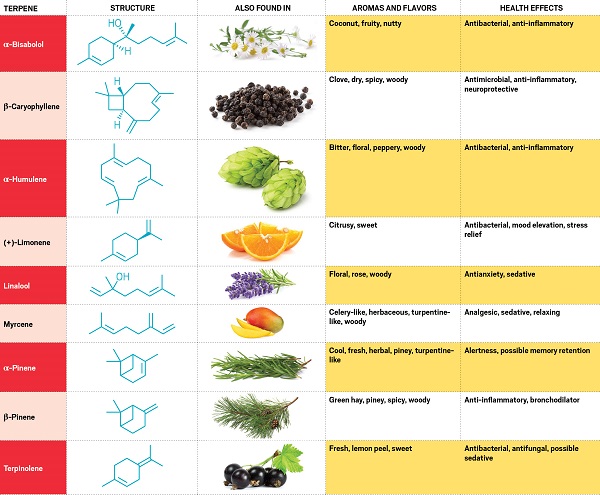
A common practice in many crops and integrated pest management systems is companion planting. This method consists of using different plants for the main crop.
By planting certain crops next to each other, growers can achieve a cooperative effort to improve production and the quality of their products. Companion planting is used to attract pollinators and beneficial insects, as well as to deter pests, add nutrients to the soil or extract minerals from the ground.
In addition, some plants that increase the production of essential oils and improve the taste of neighboring plants have been shown to be suitable for companion seeding. In particular, plants such as nettle, yarrow, basil, green onions and tarragon are considered most effective in this regard.
Lighting
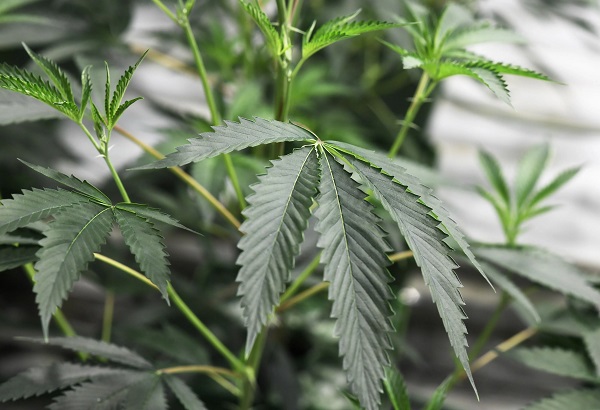
Lighting plays a key role in the cultivation process, ensuring proper plant development, increased yields and overall product quality. In addition, different light sources and light spectra can cause several different terpene profiles. For example, the same strain grown outdoors will have a different chemical profile than the one grown indoors under HPS or LED lamps.
When it comes to terpenes, two types of light spectrum play a particularly important role. By excluding the red spectrum in the last 72 hours of growth, the plant is still synthesizing terpenes, but they are not released. This leads to an accumulation of terpenes in the maturing buds.
The second important light spectrum is UV-B. This type of light can be used to increase the amount of terpenes. Adding 10-20 watts of UV-B light per square meter for the last 2-3 weeks will increase the amount of terpenes in your buds. HPS bulbs, which already contain a large infrared peak in the 800 to 900 nm range, do not require an additional UV source. If you are growing outdoors, make sure that all your buds are getting enough light.
Reducing CO2 levels
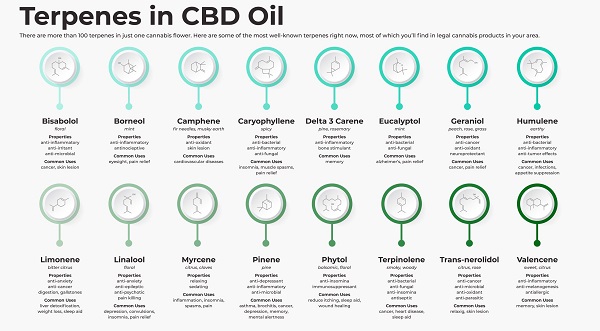
During photosynthesis, plants absorb carbon dioxide (CO2) and water, converting them into oxygen and glucose (sugar). In some conditions, growers add CO2 to the growing medium to increase the speed and volume of the process.
The ideal time to add CO2 is the first two to three weeks of flowering, when the plants begin to form buds. It is important to allow them to fully mature.
If atmospheric CO2 levels drop, the plants begin to produce the hormone ethylene, which is necessary for ripening. Increasing the amount of ethylene in stimulates the trichomes to put more energy into the production of resin and, therefore, increases the level of terpenes.
Flushing

Plants need nutrients to form leaves, stems, branches and buds. They absorb nutrients through their roots and store them in their leaves and buds. But by the last stage of growth, the plants don’t need to be fertilized.
During the last two weeks, flushing the plants with clean water ensures that all excess nutrients are removed. The remaining ones can leave an unpleasant smell and taste, and cause the buds to burn unevenly. To avoid this, you need to flush the soil several times with more water than the container capacity. At the end, you need to let the soil dry and water the plants using clean water for a pleasant and natural end product.
To get the most out of flushing, manufacturers can flush the soil with 3-5 times the amount of clean water equal to the volume of dirt in the container. So, if your container holds 5 liters, you will need 15-25 liters to flush. As opposed to watering your plants with just water for the last two weeks, this ensures that any remaining nutrients will also be flushed out of the soil. When you have done this, let the soil dry well and continue watering your plants with clean water.
It is necessary to harvest at a certain time

It is especially important to know when to harvest, and the same goes for terpenes. As the plants mature, their scent becomes more intense and sometimes even changes. As with cannabinoids, the best time to harvest is when the trichomes start to turn amber.
If you harvest too early, your buds will have fewer trichomes and therefore fewer cannabinoids and terpenes. If you harvest too late, the trichomes will break down and you will start losing both terpenes and cannabinoids.
Drying and curing
Drying the buds properly is key to growing cannabis and can have a significant impact on the harvest. Many growers are in a hurry to taste the fruits of their labor, so they try to speed up the process. To dry the buds correctly you need a dark place with a stable humidity of between 45% and 55% and a temperature of between 20°C and 22°C.
If you want to preserve the terpenes and cannabinoids in the cones, you need to dry them slowly and evenly. The slower the drying process, the better the quality of the cones is preserved. Usually, a proper drying process takes about 2-3 weeks, but this depends on the method chosen.
After the cones are dried, they must go through a curing process. This process continues the drying process, and can last anywhere from 4-5 weeks to several months. Some changes occur, such as THC turning into CBN, but when it comes to terpenes, they are better preserved longer.
During the first few weeks of the curing process, cannabinoid and terpene levels in the buds begin to decline. After a few weeks, however, the levels of these substances begin to increase. Typically, by the eighth week of the curing process, terpene levels are at their lowest during the entire curing process.
After 8 weeks of maturation, the buds of cannabis plants begin to decrease in terpenes and cannabinoids. However, with proper storage under certain atmospheric conditions (air, vacuum, N2, argon or CO2) the terpenes can increase, even up to 20%. Faster drying and ripening of the cones can lead to a loss of aroma and flavor, making them look like hay or chlorophyll.
Terpenes, like cannabinoids, are produced in the trichomes of the plant. Under stressful conditions and optimal growing conditions, more trichomes and terpenes can be produced in the plant. Careful drying and pruning will help keep the cones fresh, aromatic and tasty.
If you have experience with increasing the terpenes in your plants, share your experience in the comments.

